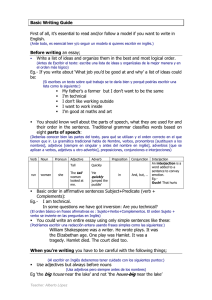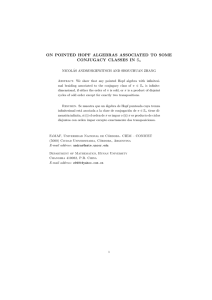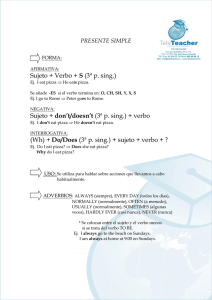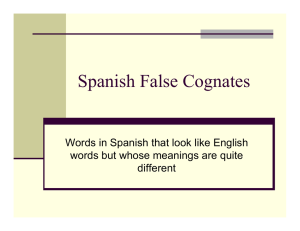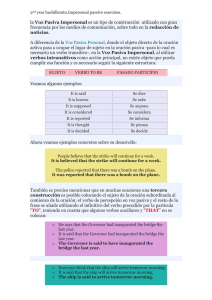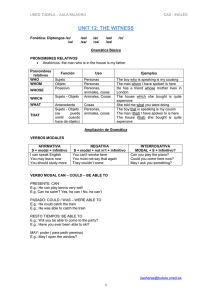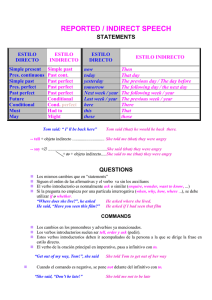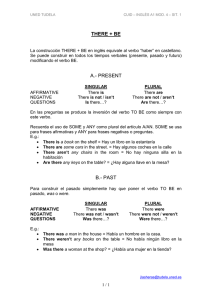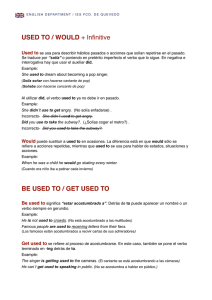WORD ORDER IN ENGLISH – EL ORDEN DE LAS PALBRAS EN
Anuncio
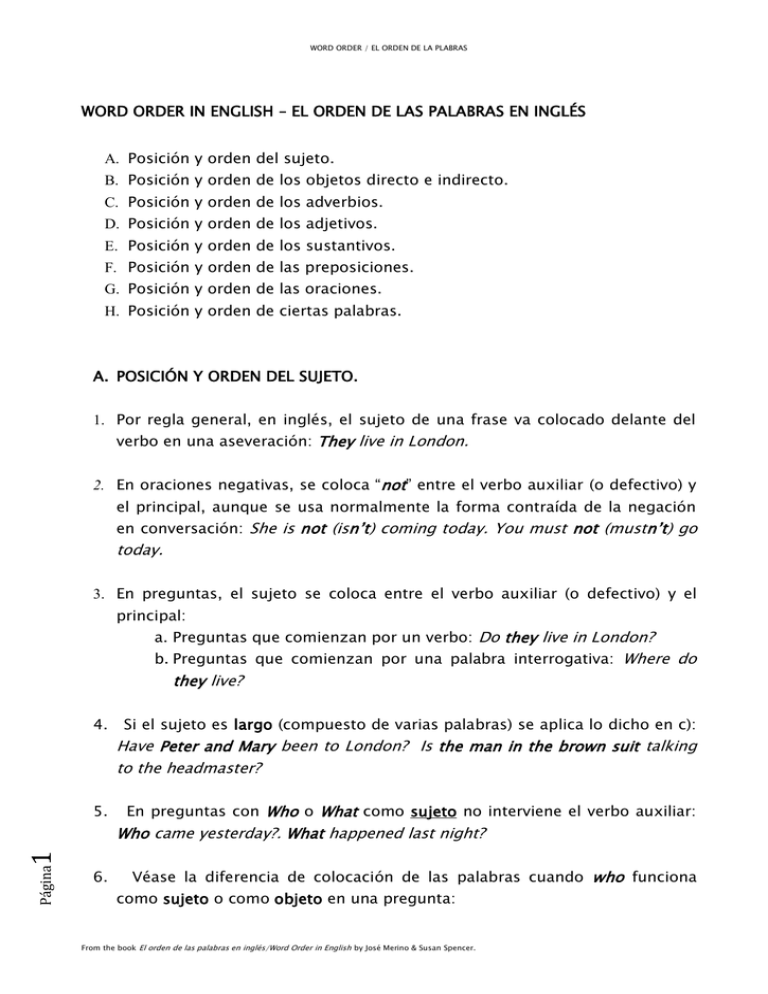
WORD ORDER / EL ORDEN DE LA PLABRAS WORD ORDER IN ENGLISH – EL ORDEN DE LAS PALABRAS EN INGLÉS A. Posición y orden del sujeto. B. Posición y orden de los objetos directo e indirecto. C. Posición y orden de los adverbios. D. Posición y orden de los adjetivos. E. Posición y orden de los sustantivos. F. Posición y orden de las preposiciones. G. Posición y orden de las oraciones. H. Posición y orden de ciertas palabras. A. POSICIÓN Y ORDEN DEL SUJETO. 1. Por regla general, en inglés, el sujeto de una frase va colocado delante del verbo en una aseveración: They live in London. 2. En oraciones negativas, se coloca “not” entre el verbo auxiliar (o defectivo) y el principal, aunque se usa normalmente la forma contraída de la negación en conversación: She is not (isn‟t) coming today. You must not (mustn‟t) go today. 3. En preguntas, el sujeto se coloca entre el verbo auxiliar (o defectivo) y el principal: a. Preguntas que comienzan por un verbo: Do they live in London? b. Preguntas que comienzan por una palabra interrogativa: Where do they live? 4. Si el sujeto es largo (compuesto de varias palabras) se aplica lo dicho en c): Have Peter and Mary been to London? Is the man in the brown suit talking to the headmaster? 5. En preguntas con Who o What como sujeto no interviene el verbo auxiliar: Página 1 Who came yesterday?. What happened last night? 6. Véase la diferencia de colocación de las palabras cuando who funciona como sujeto o como objeto en una pregunta: From the book El orden de las palabras en inglés/Word Order in English by José Merino & Susan Spencer. WORD ORDER / EL ORDEN DE LA PLABRAS SUJETO: Who killed the tiger? OBJETO: Who did the tiger kill? 7. En preguntas negativas, el sujeto, seguido de not, se coloca detrás del verbo auxiliar (o defectivo) aunque, normalmente, en conversación, se usa la forma contraída de la negación: Is he not coming t oday? = Isn‟t he coming today?. Does he not live in Celanova? = Doesn‟t he live in Celanova? 8. El sujeto de una oración afirmativa va colocado detrás del verbo auxiliar (o defectivo) igual que en la forma interrogativa, cuando ciertos adverbios o frases adverbiales, la mayoría de CARÁCTER NEGATIVO, se colocan al comienzo de la frase con objeto de dar énfasis a la idea. Esto se conoce como “INVERSIÓN”. Ejemplos: At no time: At no time has it been easier to enter a university than nowadays. Hardly: Hardly I had begun work when the telephone rang. In no circumstances: In no circumstances would my father agree to such a plan. In no way: In no way did Sally Parker show her true feelings. Little: Little does she know what I have to tell her. Never: Never have I seen such a bad film. No sooner: No sooner had Jill said that than she realised her mistake. Nowhere: Nowhere could you find a better teacher. Not only: Not only has Peter Jones a Ferrari but he is also tremendously rich. Not until: Not until it rained did my sister buy an umbrella. Often: Often have we heard it said that Jack Hill is not to be trusted. On no account: On no account must this book be taken away. Only: Only by shouting was the old man able to make himself heard. Rarely: Rarely do the Wilsons come to see us now. Seldom: Seldom does my daughter get up before nine o‟clock in the morning. 9. La estructura en la que los adverbios aparecen colocados en posición Página 2 inicial (apartado anterior) es más bien de carácter formalista. Dichos adverbios pueden ir también en su posición normal donde no afectan al orden del sujeto en la oración: I had hardly begun work when the telephone From the book El orden de las palabras en inglés/Word Order in English by José Merino & Susan Spencer. WORD ORDER / EL ORDEN DE LA PLABRAS rang. I have never seen such a bad film. My daughter seldom gets up before nine o‟clock in the morning. 10. La inversión del sujeto se efectúa también con otros adverbios, en estructuras de uso muy corriente como: Neither: I couldn‟t speak to the manager. – Neither could I. Nor: I couldn‟t speak to the manager. – Nor could I. So: I speak French and Spanish. – And so does he. 11. Con los adverbios here y there hay inversión cuando el sujeto es un nombre o sustantivo y no la hay cuando el sujeto es un pronombre personal: HERE: Here are the books! Here they are! THERE: There is Sally! There she is! 12. También, con el adverbio there hay inversión en estilo narrativo: Once upon a time there lived a king who had two daughters / Everything was silent and then there came a loud knocking at the door. 13. Cuando la oración comienza por adverbios como: down, in, off, out, up, etc. hay inversión cuando el sujeto es un NOMBRE o SUSTANTIVO y no se produce la inversión cuando el sujeto es un PRONOMBRE. Ejemplos: DOWN: Down fell two apples! / Down they fell! IN: In came the boy! / In he came! OFF: Off went Jill! / Off she went! OUT: Out went the girls! / Out they went! UP: Up jumped the monkey! / Up it jumped! 14. La inversión de SUJETO/VERBO se usa también para indicar una oración condicional, aunque su uso es más bien de carácter formalista: Should I see Página 3 Susan today, I‟d let you know / Had I known, I would never have asked her to help us / Were I rich, I would buy a Rolls Royce. Es mucho más corriente el orden normal, con el sujeto delante del verbo: If I should see Susan today, I‟d let you know / If I had known, I would never have asked her to help us / If I were rich, I would buy a Rolls Royce. 15. En expresiones como “dijo”, “respondió”, “exclamó”, etc. puede haber o no inversión de sujeto/verbo, aunque hay tendencia a la no inversión, cuando el sujeto es un PRONOMBRE PERSONAL y a la inversión cuando el sujeto es un From the book El orden de las palabras en inglés/Word Order in English by José Merino & Susan Spencer. WORD ORDER / EL ORDEN DE LA PLABRAS PRONOMBRE o un SUSTANTIVO: „Good afternoon‟,„he said in a pleasant voice / „Good afternoon‟, said the boy in a pleasant voice / „Good afternoon‟, said John in a pleasant voice. 16. Hay inversión cuando la oración comienza por una expresión adverbial de LUGAR o TIEMPO. En este caso el sujeto va colocado después del verbo. Esta estructura se usa preferentemente en estilo narrativo o para dar énfasis a la idea: In the centre of the town is situated the War Memorial / In the royal box was the queen / At the gate stood a sentinel / With him sat his family / Below the mountain lies a wide plain / Now came the fourth and final bomb. 17. En estilo colloquial, se usa el orden normal SUJETO-VERBO: The War Memorial is situated in the centre of the town / The queen was in the royal box / A sentinel stood at the gate / His family sat with him. 18. La inversion indicada en 16. no se origina si el sujeto es un PRONOMBRE PERSONAL: It is situated in the centre of the town / She was in the royal box / He stood at the gate / They sat with him. 19. No hay inversión de SUJETO-VERBO en oraciones subordinadas (entre las que se encuentran las PREGUNTAS INDIRECTAS) introducidas por una palabra interrogativa, lo que difiere del español: a) PREGUNTA DIRECTA: Where is Peter? b) PREGUNTA INDIRECTA EN ORACIÓN SUBORDINADA: Do you know where Peter is? / I‟d like to know where Peter is. 20. En los siguientes ejemplos aparecen PAREJAS DE ORACIONES. La primera es una PREGUNTA DIRECTA y la segunda CONTIENE A LA PRIMERA FORMA DE ORACIÓN SUBORDINADA. Fíjate que el orden de esta última ha cambiado y Página 4 es SUJETO-VERBO: Where does she live? / Do you know where she lives? When is John coming? / Can you tell me when Bob is coming? What is that? / Does anybody know what that is? What does Robert know? We don‟t know what Robert knows. Who are you? Tell us who you are. When is she going to Briviesca? He asks when she is going to Briviesca. From the book El orden de las palabras en inglés/Word Order in English by José Merino & Susan Spencer. WORD ORDER / EL ORDEN DE LA PLABRAS Why did you do it / I want to know why you did it. What have you bought? / Show me what you have bought. 21. Ejemplos de preguntas indirectas introducidas por HOW, WHERE, WHO o WHAT, cuyo sujeto está compuesto de varias palabras y en las que el verbo está desplazado al final: I want to know how your sister Molly is. I want to know where the new railway station is. I‟d like to know who the man sitting at the back of the room is. I‟d like to know what the Spanish for window is. 22. Se observa por los siguientes ejemplos que con las palabras WHO o WHAT no hay inversión en las preguntas indirectas si les sigue un ADVERBIO o EXPRESIÓN ADVERBIAL: Who is there? / I want to know who is there. Who is in the house? / I want to know who is n the house. What‟s on the table? / I want to know what‟s on the table. 23. Fíjate en los siguientes ejemplos con determinadas palabras que suelen ser motivos de DIFICULTAD porque en la oración subordinada inglesa no se invierte el orden sujeto-verbo y sí en español: WHEN: When your brother comes, I‟ll… = Cuando venga tu hermano, yo… UNTIL: I won‟t tell you anything about it until your brother comes = …hasta que venga tu hermano. THAT: This is the cake that the children like = …que les gusta a los niños. WHAT: Tell me what your sister knows = …lo que sabe tu hermana. UNLESS: I refuse to do it unless your father helps me = …a menos que me ayude tu padre. Página 5 24. No hay inversión en EXCLAMACIONES, a diferencia del español: How well John looks! How sweetly she sings! How difficult the lesson is! You don‟t know how difficult the lesson is! From the book El orden de las palabras en inglés/Word Order in English by José Merino & Susan Spencer. WORD ORDER / EL ORDEN DE LA PLABRAS You don‟t know how difficult the lesson that has to be learnt by heart is (la forma verbal se desplaza al final después de la oración de relativo.) B. POSICIÓN Y ORDEN DE LOS OBJETOS DIRECTO E INDIRECTO. 25. En general, el OBJETO INDIRECTO – en forma de PRONOMBRE, NOMBRE o SUSTANTIVO – puede ir colocado de dos maneras en inglés. A) Detrás del verbo y seguido del objeto directo: I gave them some books. She sent Mr Hill the money. The teacher lent the girl a dictionary. B) Detrás del OBJETO DIRECTO precedido de la preposición to: I gave some books to them. She sent the money to Mr Hill. The teacher lent a dictionary to the girl. 26. Cuando el OBJETO INDIRECTO es un PRONOMBRE PERSONAL, es muy corriente colocarlo detrás del verbo seguido del objeto directo: I gave them some books. She sent him the money. The teacher lent her a dictionary. 27. Cuando los dos objetos son PRONOMBRES PERSONALES, el indirecto, precedido de TO, sigue al directo: I gave it to them. She sent it to him. The teacher lent it to her. 28. Si el objeto es un PRONOMBRE PERSONAL, la colocación es la descrita en 25: A) Con el pronombre ONE: Página 6 I‟ll send Jack one. I‟ll send one to Jack. B) Con el pronombre SOMETHING: I‟ll send Jack something. I‟ll send something to Jack. From the book El orden de las palabras en inglés/Word Order in English by José Merino & Susan Spencer. WORD ORDER / EL ORDEN DE LA PLABRAS 29. Cuando el OBJETO INDIRECTO es largo, este va colocado, precedido de TO, detrás del directo: A) Objeto indirecto LARGO compuesto de varias palabras: The shopkeeper sold all the sweets to a group of children. We have just paid the money to the local taxation officer. B) Objeto indirecto LARGO seguido de una oración de relativo: I‟ve lent my computer to the boy who lives next door. 30. Dos objetos indirectos precedidos de TO pueden aparecer estableciendo un contraste, con el deseo de enfatizar: My grandmother left all her money to my brother, not to me. 31. El orden de los objetos DIRECTO/INDIRECTO mencionados en 25 se usa con una serie de verbos transitivos (también llamados „ditransitivos‟): Página 7 DENY: The new boss denied the workers an increase in salary = The new boss denied an increase in salary to the workers. GIVE: I gave Molly a ring = I gave a ring to Molly. HAND: The librarian handed me the dictionary = The librarian handed the dictionary to me. LEAVE: My grandfather left Susan a large fortune = My grandfather left a large fortune to Susan. LEND: I lent Tim some money = I lent some money to Tim. OFFER: I offered Molly my chair = I offered my chair to Molly. OWE: Bruce owes Paul two euros = Bruce owes two euros to Paul. PASS: He passed Ronaldinho the ball = He passed the ball to Ronaldinho. PAY: I paid the man the money = I paid the money to the man. PROMISE: Mrs Evans promised her daughter a new car = Mrs Evans promised a new car to her daughter. READ: The teacher read us the letter = The teacher read the letter to us. RECITE: The girl recited the audience a poem = The girl recited a poem to the audience. RECOMMEND: Can you recommend us a good hotel? = Can you recommend a good hotel to us? From the book El orden de las palabras en inglés/Word Order in English by José Merino & Susan Spencer. WORD ORDER / EL ORDEN DE LA PLABRAS SELL: Julian sold Paul his car = Julian sold his car to Paul. SEND: I have sent Sally some flowers = I have sent some flowers to Sally. SHOW: I showed him this photo = I showed this photo to him. SING: Mary sang the children a song = Mary sang a song to the children. TAKE: She took the prisoner some water = She took some water to the prisoner. TEACH: Mr Alonso taught us English = Mr Alonso taught English to us. TELL: I told the children a story = I told a story to the children. THROW: The man threw the beggars some money = The man threw some money to the beggars. WRITE: Jack wrote his brother a letter = Jack wrote a letter to his brother. 32. Hay también otras estructuras diferentes de las descritas en 25. Los siguientes verbos tienen la estructura VERBO + OBJETO INDIRECTO (sin „to‟) + OBJETO DIRECTO: ASK: I asked Mr Smith a question. CHARGE: The waiter charged us five euros for the sandwiches. COST: The bicycle cost me a hundred euros. WISH: I wish you good luck. 33. Otros verbos, sin objeto directo expreso, van sólo acompañados de OBJETO INDIRECTO, el cual puede o no llevar „to‟ delante, dependiendo del verbo: A) VERBO + TO + OBJETO INDIRECTO: READ: Read to us, please. SING: Miss Adams sang to the children. SPEAK: I‟ll speak to him tomorrow. TALK: I‟d like to talk to her. WRITE: I‟ll write to them next week. Página 8 B) VERBO + OBJETO INDIRECTO: PROMISE: Promise me. SHOW: Show us. TELL: Tell Peter. From the book El orden de las palabras en inglés/Word Order in English by José Merino & Susan Spencer. WORD ORDER / EL ORDEN DE LA PLABRAS 34. En forma pasiva, el objeto indirecto va precedido de „ to‟: The Ferrari was sold to Tom. 35. En una oración de relativo, el OBJETO INDIRECTO puede ir o no precedido de „to‟: This is the Ferrari which I sold (to) Tom. 36. En otro tipo de estructura con verbos que admiten dos objetos se observa que el INDIRECTO debe ir precedido de „to‟: A) COLOCADO DETRÁS DEL OBJETO DIRECTO: The criminal confessed his crime to the police. B) COLOCADO DETRÁS DEL VERBO CUANDO NO HAY UN OBJETO DIRECTO: The criminal confessed to the police befote he died. C) SI EL OBJETO INDIRECTO ES MUY CORTO, CON RELACIÓN AL DIRECTO, SE COLOCA, A VECES, ANTES DE ÉSTE PRECEDIDO DE „TO‟: He confessed the police that he had stolen the Money / Peter Jones explained to us how he had done it. 37. A continuación, se pasa revista a un grupo de verbos que se incluyen en el apartado 36: ADDRESS: My father addressed his complaint to the principal. ADMINISTER: The doctor administers this medicine to his patients. ANNOUNCE: They announced the arrival of the plane to the people in the airport / They announced to us that the plane was landing. COMPLAIN: She complained to the police about the noise in her neighbourhood. COMMUNICATE: Mrs Brown communicated the news to her husband. CONFESS: The old woman confessed her crime to the police / Sally confided to me that she didn´t like Sean. DELIVER: He delivered the message to the manager. DEMONSTRATE: The teacher demonstrated the experiment to the class / I‟ll demonstrate to him that he is not right. Página 9 DESCRIBE: Please describe the scene to us / Describe to us what happened that day. DEVOTE: My sister devoted all her life to it. From the book El orden de las palabras en inglés/Word Order in English by José Merino & Susan Spencer. WORD ORDER / EL ORDEN DE LA PLABRAS ENTRUST: I don‟t like to entrust a secret to a stranger. EXPLAIN: Roger explained the problem to them / He explained to Mr Brown that the delay was inevitable. INTRODUCE: She introduced Michael to Sally. MENTION: I mentioned an alternative plan of action to them / I mentioned to the Browns that we were going abroad. POST: I posted a letter to Susan yesterday. PRESENT: John presented a new plan to the manager. PRONOUNCE: As she could not understand, I pronounced the word to her again. PROPOSE: I proposed a new plan to the Board of Directors / I proposed to them that we should buy the apartment. PROVE: I‟d like to prove something to you / I‟ll prove to you that the boy is quite unreliable. REPORT: She reported the murder to the police. RETURN: I‟ll return the books to the library tomorrow. SAY: I said goodbye to him / I said to her that I was in a hurry. SPEAK: She spoke to them in German / She spoke her lines to an appreciative audience. SUGGEST: I suggested an idea to Molly. TALK: I‟d like to talk to you about an important matter. TRANSLATE: I translated the letter to her as I read it. WRITE: I‟ll write to her next week. 38. Cuando hay dos objetos en la frase y el INDIRECTO va precedido de „ for‟, hay dos posible colocaciones: A) VERBO + OBJETO INDIRECTO + OBJETO DIRECTO: I bought Alice a watch. B) watch for Alice. 10 Página VERBO + OBJETO DIRECTO + FOR + OBJETO INDIRECTO: I bought a 39. Si el OBJETO DIRECTO es un pronombre („it‟), solamente es posible la siguiente estructura: From the book El orden de las palabras en inglés/Word Order in English by José Merino & Susan Spencer. WORD ORDER / EL ORDEN DE LA PLABRAS VERBO + IT + FOR + OBJETO INDIRECTO: I bought it for Alice / I bought it for her. 40. Cuando el OBJETO DIRECTO es un pronombre no personal, se pueden usar las dos estructuras mencionadas en 38: A) Pronombre „one‟: I bought Alice one / I bought one for Alice. B) Pronombre „something‟ : I bought Alice something / I bought something for Alice. 41. A continuación, alfabéticamente se muestra una relación de verbos seguidos de dos objetos como se describe en 38. El INDIRECTO va introducido por „for‟: BRING: Bring her a chair / Bring a chair for her. BUILD: He built them a house / He built a house for them. BUY: Let‟s buy him a book / Let‟s buy a book for him. CASH: Please cash me this cheque / Please cash this cheque for me. CHOOSE: Choose him a tie / Choose a tie for him. COOK: She cooked us a good dinner / She cooked a good dinner for us. CUT: Cut me a slice of cake / Cut a slice of cake for me. FETCH: Fetch me a hammer / Fetch a hammer for me. FIND: I‟ll find Sally a seat / I‟ll find a seat for Sally. GET: Please get us two tickets / Please get two tickets for us. KEEP: I kept Judy a seat / I kept a seat for Judy. LEAVE: Have you left him any cake? Have you left any cake for him? MAKE: She made Jim a cake / She made a cake for Jim. Página 11 ORDER: Order me a glass of water / Order a glass of water for me. PLAY: Play the children a song / Play a song for the children. REACH: Reach me my walkman, please / Reach my walkman for me, please. From the book El orden de las palabras en inglés/Word Order in English by José Merino & Susan Spencer. WORD ORDER / EL ORDEN DE LA PLABRAS 42. Hay un grupo de verbos que únicamente se construyen con „for‟ delante del OBJETO INDIRECTO: ARRANGE: Fred will arrange the matter for us. BEGIN: I began the work for him. DRAW: Bob drew a picture for the child. FINISH: I‟ll finish the work for her. MEND/FIX: I‟ll mend/fix the car for you. OPEN: He opened the door for me. PRESCRIBE: Dr Brown prescribed some pills for Tom / Dr Brown prescribed him some pills. C. POSICIÓN Y ORDEN DE LOS ADVERBIOS. 43. En inglés un adverbio puede ir colocado: a) Delante de un adjetivo: I am terrible sorry. b) Delante de otro adverbio: My brother John drives very carefull c) Delante de un verbo: He quickly oponed the box and took out the money. d) Delante de un sustantivo: Wait just a minute, please. e) Delante de un pronombre: It‟s only me. f) Delante de un participio pasado: The setter was badly written. g) Delante de una frase: It was almost in the winter. h) Después de un verbo: The policeman spoke slowly. i) Después del objeto directo: The teacher explained the lesson carefully. 44. Los adverbios de MODO, LUGAR y TIEMPO se colocan, por regla general, detrás del verbo o del objeto directo, si lo hay: a) MODO: Jim spoke fluently / Jim spoke French fluently b) LUGAR: Jim spoke in class / Jim spoke French in class. Página 12 c) TIEMPO: Jim spoke this morning / Jim spoke French this morning. 45. En la oración, el orden de estos adverbios, por regla general es MODO/MANNER – LUGAR/PLACE – TIEMPO/TIME: Jim spoke French fluently in class this morning / Jake played the piano very well at the party last night. From the book El orden de las palabras en inglés/Word Order in English by José Merino & Susan Spencer. WORD ORDER / EL ORDEN DE LA PLABRAS 46. En el caso de acumularse varios adverbios, el de tiempo suele colocarse al principio de la frase: This morning Jim spoke French fluently in class / Last night Jake played the piano very well at the party. 47. En caso de figurar dos adverbios en la oración, el orden sería: a) Modo – lugar: Pepe works hard in the office. b) Modo – tiempo: Pepe works hard every day. c) Lugar – tiempo: Pepe works in the office every day. 48. Además de las colocaciones “standard” de los adverbios (ver 44), hay casos en que los adverbios toman diferentes posiciones en la frase por diferentes razones: cuando el objeto directo es largo, por ejemplo por ir seguido de una oración de relativo, el adverbio de modo se puede colocar delante o detrás del verbo: He pronounced carefully the words that she had to write / He carefully pronounced the words that she had to write. 49. Nótese que la colocación del adverbio de modo al final de la oración subordinada tendría otro sentido: He pronounced the words that she had to write carefully. De la misma manera: She quickly asked who had brought the letter / She asked who had brought the letter quickly. 50. Hay adverbios de modo que se colocan delante del sujeto por énfasis: Slowly Mr Watson rose from his seat. Thoughtfully Jack entered the dining-room. Suddenly the boy stepped forward. 51. En las oraciones pasivas, el adverbio de modo se coloca normalmente delante del participio pasado: The letter was badly written. The book is carefully printed. 52. Cuando el objeto directo es largo, por ir seguido de una oración de Página 13 relativo, la expresión de lugar se coloca detrás del verbo. Nótese la diferencia entre una frase con objeto directo corto y otra con objeto directo largo: She put the plates on the table. From the book El orden de las palabras en inglés/Word Order in English by José Merino & Susan Spencer. WORD ORDER / EL ORDEN DE LA PLABRAS She put on the table the plates that were needed for dinner. 53. Cuando hay dos adverbios de lugar en una oración, el más concreto precede al más general: The Browns live in a little house on a hill. 54. Los adverbios de lugar se colocan normalmente detrás de un vero de movimiento con objeto de completar el sentido: Tim went to the office in a hurry this morning. 55. Con respecto a los adverbios o expresiones adverbiales de tiempo, pueden hacer cambiar el sentido, según se coloquen en la oración principal o en la subordinada: Mary told me yesterday what Susan said. Mary told me what Susan said yesterday. 56. Cuando hay dos adverbios o frases adverbiales de tiempo en la misma oración, el más concreto normalmente precede al más general: The Chinese restaurant closes at five o‟clock on Saturdays. 57. Los adverbios de tiempo indefinido o frecuencia se colocan delante del verbo principal o detrás de „to be‟: I sometimes go to the club. I have seldom done it. You should always come in the morning. You must never say that. He is often late for dinner. 58. Los adverbios de grado, que modifican a un verbo, a un adjetivo o a otro adverbio, se colocan delante de la palabra que modifican: I entirely agree with you. The film is very good. I know her quite well. Página 14 59. Muchos adverbios cambian de posición con objeto de dar énfasis. A continuación se exponen los que pueden tomar posición inicial, posición media y posición final: afterwards: From the book El orden de las palabras en inglés/Word Order in English by José Merino & Susan Spencer. Página 15 WORD ORDER / EL ORDEN DE LA PLABRAS Afterwards we shall return to Briviesca. We shall afterwards return to Briviesca. We shall return to Briviesca afterwards. carefully: Carefully she signed the contract. She carefully signed the contract. She signed the contract carefully. evidently: Evidently she enjoyed the film. She evidently enjoyed the film. She enjoyed the film evidently. fortunately: Fortunately she spoke German. She fortunately spoke German. She spoke German fortunately. naturally: Naturally we don‟t want to be late. We naturally don‟t want to be late. We don‟t want to be late naturally. once: Once they went to Oña. They once went to Oña. They went to Oña once. personally: Personally I like Joyce‟s novels. I personally like Joyce‟s novels. I like Joyce‟s novels personally. recently: Recently I went to Poza. I recently went to Poza. I went to Poza recently. sometimes: Sometimes I visit them. I sometimes visit them. I visit them sometimes. stupidly: Stupidly I smiled. From the book El orden de las palabras en inglés/Word Order in English by José Merino & Susan Spencer. WORD ORDER / EL ORDEN DE LA PLABRAS I stupidly smiled. I smiled stupidly. then: Then we went for a walk. We then went for a walk. We went for a walk then. already: I have already opened the window. I have opened the window already. always: She has always done that. She always has done that. (esta posición sugiere énfasis) first: When did you see them first? When did you first see them? last: When did you see them last? When did you last see them? never: We can never leave the baby. We never can leave the baby. only: There are only blue shirts. There are blue shirts only. rather: It was rather a hot day. It was a rather hot day. still: Her sister is still prettier. Her sister is prettier still. yet: My friends haven‟t arrived yet. My friends haven‟t yet arrived. Página 16 60. Hay otros adverbios que pueden tomar dos posiciones: From the book El orden de las palabras en inglés/Word Order in English by José Merino & Susan Spencer. WORD ORDER / EL ORDEN DE LA PLABRAS 61. Con verbos que rigen una preposición, el adverbio se coloca entre el verbo y dicha preposición: I have looked everywhere for my match. He looked carefully at the pictures on the wall. 62. Las partículas adverbiales de los Phrasal Verbs pueden tener las siguientes posiciones en una frase con un verbo transitivo: a) Si el objeto directo es un sustantivo, el adverbio se coloca detrás del verbo o del objeto directo: He put on his hat. He put his hat on. b) Si el objeto directo es un pronombre, el adverbio se coloca detrás de éste: He put it on. c) Si detrás del objeto directo hay una oración de relativo, el adverbio se coloca detrás del verbo: He put on the hat that was on the chair. 63. Las partículas adverbiales de los Phrasal Verbs, en frases con verbos intransitivos, se colocan detrás del verbo: They came down at once. 64. En voz pasiva, las partículas adverbiales no se separan del verbo: The books were taken away. The books were brought in. 65. Hay dos expresiones adverbiales cuya colocación es siempre motivo especial de dificultad para los hispanohablantes: very well y very much. Ambas deben ir detrás del objeto directo y no entre el verbo y el objeto. Así se dice: He speaks English very well. (NO: He speaks very well English) Página 17 He likes tea very much. (NO: He likes very much tea) D. POSICIÓN Y ORDEN DE LOS ADJETIVOS. 66. El adjetivo, cuando funciona como atributo, se coloca delante del sustantivo: From the book El orden de las palabras en inglés/Word Order in English by José Merino & Susan Spencer. WORD ORDER / EL ORDEN DE LA PLABRAS Celanova is a famous town. 67. Cuando el adjetivo va seguido de una preposición, se coloca, por regla general, detrás del sustantivo: Toledo is a town famous for its catedral. This is a job unsuitable for me. También pueden expresarse estas oraciones con el adjetivo delante del sustantivo: Toledo is a famous town for its cathedral o This is an unsuitable job for me. En los siguientes casos no es posible el cambio: This is good oil for salads. This is a subject worthy of attention. 68. El adjetivo, usado como predicado, se coloca después de los llamados “link verbs” como „be, become, get, look, seem, turn‟, etc…: I am tired. The weather became cold during the night. The teacher got angry. She looks happy. That seems important. Molly turned pale when she heard the news. 69. Hay adjetivos que sólo pueden usarse como predicado: „ afraid‟, „alike‟, „alive‟, „alone‟, „ill‟: Don‟t be afraid of me. These two cars are alike. The cat that had fallen into the river was still alive. I‟d like to be alone. Peter is ill. 70. Los adjetivos aparecen detrás de sustantivos o pronombres en algunos casos, como: Página 18 a) En expresiones de medida: This table is three feet high. The river is one mile wide. From the book El orden de las palabras en inglés/Word Order in English by José Merino & Susan Spencer. WORD ORDER / EL ORDEN DE LA PLABRAS b) Después de los pronombres compuestos con –body y - c) thing: I met somebody important. Tell me something new. Tras cierts verbos como „to dye‟, „to find‟, „to keep‟, „to colour‟, etc., para indicar un resultado: Molly dyed her blouse blue. They found the dog dead. Keep the room clean. 71. Nota la diferencia de significado al usar el adjetivo delante o detrás del sustantivo con verbos como los mencionados en 70c): She has dyed her blue dress. She has dyed her dress blue. He found his wounded brother. He found his brother wounded. Jack painted the green door. Jack painted the door green. She colours her red lips. She colours her lips red 72. Los participios pasados usados como adjetivos aparecen, en algunos casos, detrás de los sustantivos, implicando una oración de relativo: The goods ordered have not arrived yet. (The goods which were ordered…). The names mentioned were crossed off the list. (the names which were mentioned…). 73. En anuncios, los participios pasados se colocan detrás de los sustantivos, Página 19 con el verbo „be‟ omitido: English spoken (= English is spoken). Antiques bought and sold (= Antiques are bought and sold). From the book El orden de las palabras en inglés/Word Order in English by José Merino & Susan Spencer. WORD ORDER / EL ORDEN DE LA PLABRAS 74. Cuando hay dos adjetivos que califican a un sustantivo, se coloca justamente delante de éste el que sea objetivo y delante de este adjetivo el que sea subjetivo: A pretty young girl. El adjetivo young es objetivo (todo el mundo puede apreciar que la chica es joven) El adjetivo pretty, delante de young, puede ser subjetivo (no a todo el mundo puede parecerle guapa). Similar a esto: A fine old house. A nice big room. 75. Además de lo dicho en 74, se dan unas normas generales para la colocación de los adjetivos delante de un sustantivo, según indiquen tamaño, color, cualidad, nacionalidad, materia, forma, etc. a) Tamaño – color: A small blue chair. b) Cualidad – nacionalidad: A tall English boy. c) Cualidad – materia: A nice silk handkerchief. d) Color – materia: A blue plastic bag. e) Forma – material: A long silk dress. f) Color – nacionalidad: A red Spanish car. g) Edad – nacionalidad: An old Persian carpet. h) Tamaño – color – nacionalidad: A small red Chinese vase. i) Cualidad – edad – color: A dirty old brown hat. E. POSICIÓN Y ORDEN DE LOS SUSTANTIVOS. 76. El inglés tiene una gran capacidad para formar sustantivos compuestos, es decir, dos sustantivos que constituyen una unidad, con su significado, aunque cada uno de los dos sustantivos por separado signifiquen cosas distintas. Cuando se da esta combinación, el primer sustantivo actúa como adjetivo del segundo. Así, “a pocket match” significa “reloj de bolsillo” pero, sin embargo, “a watch pocket” significa “bolsillo para guardar el Página 20 reloj.” Otros ejemplos: A horse-race. A race-horse. A flower-garden. A garden flower. From the book El orden de las palabras en inglés/Word Order in English by José Merino & Susan Spencer. WORD ORDER / EL ORDEN DE LA PLABRAS An eye-glass. A glass eye. 77. Hay muchísimas combinaciones de sustantivo + sustantivo en inglés, para indicar tiempo posición, uso, etc. Otros ejemplos: Bookshop. Handbook. Housewife. Newspaper. Shoe-shop. Street lamp. Teacup. Telephone book. Week-end/weekend/week end. 78. Es muy corriente la combinación sustantivo + sustantivo designando un agente: Bookseller. Fortune-teller. Pain-killer. Schoolmaster. Vacuum cleaner. 79. También puede haber varios sustantivos haciendo de adjetivos de uno final, como en: Town power supply. Car cigarette lighter. Boy Scout movement. Discount coach card. F. POSICIÓN Y ORDEN DE LAS PREPOSICIONES. Página 21 80. Por regla general, las preposiciones van colocada delante de los sustantivos, nombres o pronombres. También preceden a los GERUNDS: The book is on the table. They live in Madrid. From the book El orden de las palabras en inglés/Word Order in English by José Merino & Susan Spencer. WORD ORDER / EL ORDEN DE LA PLABRAS I often think of her. Bob grew pale on hearing the news. 81. El orden normal de las preposiciones descrito en 80) puede variar en casos como: a) En preguntas que comienzan con una palabra interrogativa como what, which, where, who, la preposición va colocada detrás de dicha palabra interrogativa (si no hay verbo) o bien detrás del verbo o del objeto directo (si lo hay): What about? What are you talking about? What is this for? What did you cut the bread with? Which car are you going in? Where are they going to? Who is he talking to? b) La preposición, que iría colocada delante del pronombre relativo en estilo formalista, se desplaza al final en lenguaje corriente: This is the boy I gave the prize to = This is the boy to whom I gave the prize. That is the knife I cut the bread with = That is the knife with which I cut the bread. c) La preposición también se desplaza detrás del verbo u objeto directo (si lo hay) en la estructura to + infinitivo + preposition: There were many things to talk about. I want a knife to sharpen my pencil with. She gave me a chair to sit on. I couldn‟t find any magazines to look at. También se pueden construir estas oraciones colocando la Página 22 preposición delante de un pronombre relativo, lo que se emplea, por regla general, en estilo formalista: There were many things about which to talk. From the book El orden de las palabras en inglés/Word Order in English by José Merino & Susan Spencer. WORD ORDER / EL ORDEN DE LA PLABRAS d) En oraciones en pasiva, la preposición aparece al final: This garden is very well looked after. The bed had not been slept in. I don‟t like being looked at. e) También la preposición pasa al final de la frase en exclamaciones: What a mess your room is in! f) En la estructura for + gerund + preposition, indicando propósito, la preposición es desplazada al final de la oración. A pen is for writing with. A handbag is for putting things in. G. POSICIÓN Y ORDEN DE LAS ORACIONES. 82. El orden ORACIÓN PRINCIPAL – ORACIÓN SUBORDINADA se invierte a menudo, de forma que la oración subordinada aparece en primer lugar separada por una coma (,) de la principal. Así se dice: Mrs Evans didn‟t light he fire though it was cold. Though it was cold, Mrs Evans didn‟t light he fire. I shall go to the park unless it rains. Unless it rains, I shall go to the park. He will do it tomorrow if he has time. If he has time, he will do it tomorrow. Veamos una serie de oraciones compuestas que comienzan con la subordinada: As: As I said in my last setter, I am taking the exam in September. Even if: Even if we could afford it, we wouldn‟t buy a new car. Página 23 However: However much you dislike him, you must not show it. If: If you see Bob, tell him I want to talk with him. Since: Since you are tired, I‟ll drive you home. Though: Though we started early, we arrived late. From the book El orden de las palabras en inglés/Word Order in English by José Merino & Susan Spencer. WORD ORDER / EL ORDEN DE LA PLABRAS Unless: Unless I‟m mistaken, the money has been stolen. Whatever: Whatever you do, do it well. Whereas: Whereas I want a house in the country, my wife would like to live in the city. Whether: Whether you think it‟s going to rain or not, itid better to take an umbrella in case it does. While: While I was walking to school, I found a wallet. 83. En oraciones de relativo, el verbo „to be‟ y el pronombre relativo se omiten entre el sujeto y una expresión adverbial de lugar: The man in the classroom is the teacher = The man who is i the classroom is the teacher. The box on the table is made of mahogany = The book which is on the table is made of mahogany. 84. Algunos participios, adjetivos y expresiones adverbiales, a veces, se usan solos (sin el verbo „to be‟) después de algunas conjunciones, lo que es necesario conocer desde el punto de vista del orden de las oraciones. Veamos los siguientes casos: a) Conjunción + participio pasado: As: Please send us a catalogue as advertised in El País. If: If bitten by a dog, clean the wound at once. Unless: Unless called at once, your cousin will be too late to help us. When: I‟m sure Fred stole the money when left alone in the office. Whether: Whether I‟ll go to Mary‟s party whether invited or not. While: My son read a lot of books while confined to bed. b) Conjunción + participio presente: When: My neighbour found some old coins when digging in his garden. While: I cut my finger while opening a tin. Página 24 c) Conjunción + adjetivo o expression adverbial: If: If necessary, we can use my car. When: When ready, ring the bell. From the book El orden de las palabras en inglés/Word Order in English by José Merino & Susan Spencer. WORD ORDER / EL ORDEN DE LA PLABRAS Whenever: The reports should be typed whenever possible. While: While in London, you should call on Mr Wilson. H. POSICIÓN Y ORDEN DE CIERTAS PALABRAS. 85. En inglés existen ciertas palabras y expresiones cuyo significado cambia, según su colocación en la frase. Veamos una recopilación de las mismas: I don‟t like jam very much. (= No me gusta mucho la mermelada) I don‟t like very much jam (= No me gusta mucha mermelada) I have my shoes cleaned. (= Me hago limpiar los zapatos) I have cleaned my shoes (= Me he limpiado los zapatos) Ken can‟t fool me. I can see through him. (= Ken no puede engañarme. Le tengo calado) Tell him not to worry. We‟ll see him through. (= Dile que no se preocupe. Le ayudaremos a salir del apuro) Judy watches over her child. (= Judy protege a su niño) Judy watches her child over. (= Judy vigila al niño) I left without finishing the film. (= Me marché sin terminar la película – dicho por alguien que intervenía en la misma) I left without the film finishing. (= Salí sin que terminara la película – dicho por un espectador) She is still standing. (= Ella está aún de pie) She is standing still. (= Ella está de pie inmóvil) Página 25 She put the runner straight on the table. (= Ella puso el tapete directamente sobre la mesa) She put the runner on the table straight. (= Ella puso derecho el tapete en la mesa) From the book El orden de las palabras en inglés/Word Order in English by José Merino & Susan Spencer. WORD ORDER / EL ORDEN DE LA PLABRAS Happily, he did not die. (= Afortunadamente no murió) He did not die happily. (= No murió feliz) Tom admires his only brother. (= Tom admira a su único hermano) Tom admires only his brother. (= Tom admira solamente a su hermano) How big it is! (= ¡Qué grande es!) How big is it? (= ¿Cómo es de grande?) They found the wounded soldiers. (= Ellos encontraron a los soldados que ya estaban heridos) They found the soldiers wounded. (= Encontraron heridos a los soldados – los encontraron en ese estado) I have to write some letters. (= Tengo que escribir algunas cartas – es mi obligación) I have some letters to write. (= Tengo algunas cartas que escribir – es mi tarea) I want a pair of new boots. (= Quiero un par de botas nuevas) I want a new pair of boots. (= Quiero otro par de botas) Jack‟s mother had breakfast prepared by eight o‟clock (= La madre de Jack tenía el desayuno preparado antes de las ocho) Jack‟s mother had prepared breakfast by eight o‟clock (= La madre de Jack había preparado el desayuno antes de as ocho) Página 26 86. Otras palabras pueden cambiarse de posición conservando el mismo significado: We both can do it. We can both do it. From the book El orden de las palabras en inglés/Word Order in English by José Merino & Susan Spencer. WORD ORDER / EL ORDEN DE LA PLABRAS The boys all studied their lessons. All the boys studied their lessons. There‟s enough milk in the fridge. There‟s milk enough in the fridge. You yourself told me the story. You told me the story yourself. I can never understand the news in French. I never can understand the news in French. („never‟ enfático) 87. Palabras inglesas cuya colocación en la frase difiere del español: More: Two more hours. Other(s): I have to read two other books Página 27 He and two others were arrested. From the book El orden de las palabras en inglés/Word Order in English by José Merino & Susan Spencer.
